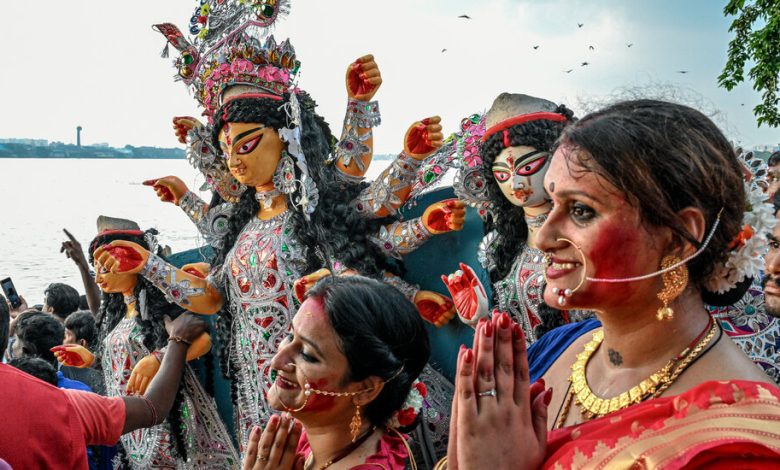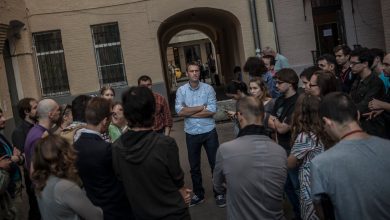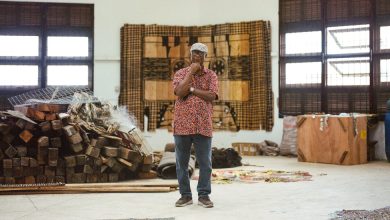A Hindu Mardi Gras Where Indian Progressivism Is Alive and Well

Purbasha Roy held her 9-year-old daughter’s hand and pointed toward the towering art installation: blooming pink buds symbolizing embryos, menstrual cups shaped to form a bouquet, fallopian tubes descending from corners of the ceiling.
The work, part of a makeshift pavilion to worship the Hindu goddess Durga, was designed to break taboos in India about menstruation. And it had a clear target: A half-man, half-bull demon at Durga’s feet, an organizer explained to Ms. Roy and others, represented the “moral police” — India’s patriarchal society.
The pavilion was one of hundreds, many politically pointed, that dotted Kolkata during a five-day festival called the Durga Puja, an event that brings this muggy, sleepy city alive each year as if jolted by a high-voltage current. Part Mardi Gras, part Christmas, the festival, which ended on Tuesday, is the most important religious celebration for Hindus in this part of eastern India.
From the dense warrens of old Kolkata to the city’s parks and apartment compounds, the makeshift pavilions, many of them wildly elaborate and colorful, feature handmade idols of the three-eyed goddess Durga, her 10 arms splayed out. The goddess, clutching a spear and a club, embodies both martial prowess and gentle motherliness — the victory of good over evil.

The Hindu goddess Durga, clutching a spear and a club, embodies both martial prowess and gentle motherliness.
Over the past few years, the festival pavilions have morphed from traditional works of art to high-tech installations representing progressive ideas, even as Prime Minister Narendra Modi’s right-wing Bharatiya Janata Party has tightened its grip on India.
The themes this year included the hardships faced by auto-rickshaw drivers; child labor and trafficking and the sexual abuse of young girls; and the suffering in the Indian state of Manipur, where Mr. Modi has been accused of indifference amid deadly ethnic warfare. An installation of a crying mountain symbolized the ravages of climate change. Social workers invited five female victims of acid attacks to a pavilion on the subject.
The pavilions carried the message that India remains a nation of diverse beliefs, with resistance to the B.J.P. and its push for Hindu homogeneity still alive and well outside the party’s stronghold in populous and relatively impoverished North India.
The B.J.P. has struggled to break into the eastern Bengal region, a leftist bastion where Kolkata is the cultural heart. The state of West Bengal, which long had a Communist government, is now led by the Trinamool Congress, a center-left secular party.
Tapati Guha-Thakurta, a historian who has traced the development of traditional worship to its contemporary manifestations and helped get the festival on UNESCO’s list of intangible cultural heritage of humanity in 2021, said the event played an important role in Kolkata’s “sociocultural and political scene.”
The state’s chief minister, Mamata Banerjee, has used the festival to “highlight her governance and project a secular outlook,” Ms. Guha-Thakurta said. The B.J.P., she added, has offered its “brawny North Indian Hindutva,” or Hindu nationalism, as a contrast before a general election next year.
A festival pavilion installed by a local B.J.P. politician, Sajal Ghosh, featured an imposing replica of a Hindu temple being constructed at the site of a destroyed mosque in Ayodhya, a highly charged symbol that Hindus and Muslims have clashed over for decades.
The temple, dedicated to Lord Ram, is a core ideological issue of the Hindu right wing, and its expected opening early next year is likely to be a main religious talking point for Mr. Modi and his party before the election. Hindu nationalists have increasingly embraced the male god Ram and cast him as warlike, in contrast to the diverse expression of Hinduism around other deities outside North India, with the goddess Durga being the main one in Bengal.
On Saturday, Mr. Ghosh shook hands with onlookers and shouted “Jai Shri Ram,” or “Hail Lord Ram” — a frequent right-wing war cry against religious minorities — in a bid to rouse the crowds. The same chant also blared from loudspeakers.
Thousands of men, women and children, their sweaty bodies pressed against one another, jostled for space to click selfies with the temple replica as the backdrop. Mr. Ghosh, who had traveled to Ayodhya to get exact measurements, said those selfies, sure to be shared far and wide, are “my prize.”
Jawhar Sircar, a member of Parliament representing the Trinamool Congress, said that the B.J.P. did not understand the syncretic culture of Bengal, a region that remains Hindu and follows a social structure of “giving freedom to women.”
“The B.J.P. suffers from what we call the homogenization fever,” Mr. Sircar said. “They feel that the whole of India must be in that homogenic line of a central worship. The Ram temple signifies that. What they forget is that India is a confederation of ideas and cultures.”
The divergence in Bengal could be seen in the menstruation pavilion. The chief organizer, Ellora Saha, a local Trinamool Congress politician, explained to a rapt group of women and men that a young girl depicted in the installation was pushing against a hand representative of an “evil society” that bars her from entering temples during her period.
“Without the menstrual cycle, a woman is incomplete,” Ms. Saha said. “God has blessed us through this system to give birth to a new life. And that is nothing to be ashamed about.”
“Durga Puja is all about empowerment of female powers,” she added. “And if we can worship an idol, why don’t we every single woman?”
Not all of the festival’s pavilions, known as pandals, had a political message. Some served as an escape from the drudgery of daily life, transporting the burgeoning middle classes to faraway lands. Disneyland, for instance, or Hogwarts.
Crowds pressed from one pavilion to another on foot, decked out in their finery, with some walking miles for “pandal hopping.” The fragrance of fresh marigolds and tuberoses mingled with the smell of incense. Rhythmic beats of traditional percussion instruments could be heard from afar. Sweets shops and stalls selling noodles or puchkas, a deep-fried Kolkata street food, did a brisk business.
Still, many festivalgoers like Ms. Roy said they preferred the pavilions with “social messaging more than the blingy ones.”
“Day by day, Pujas are turning a new page. And my daughter is not going to follow the taboos we were made to,” Ms. Roy said as she looked at her 9-year-old, Reetika.
Bhabatosh Sutar, an installation artist, said he had decided to create a pandal after being shaken to his core by the news of women being paraded naked during the ethnic violence in Manipur. His pavilion, called “Gano Devta,” or “Deity of the Masses,” featured a 15-foot idol of a woman symbolizing Durga. The idol was rough and colorless, with bruises all over.
At the pavilion on child trafficking and sexual assaults against women and girls, Sritama Adhya, 27, stood in front of an installation made of a huge brown sack from which a little girl’s hands and legs protruded, her rotund face sticking up at the top.
“This art installation will spread a message to the masses,” Ms. Adhya said. “I would say this kind of Puja installation which gives a social message while maintaining the religious aspect of this tradition is more meaningful than a replica of a yet-to-be-constructed temple.”





